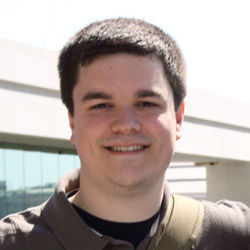
In Part 1 I described the prelaunch strategy of GTRI's I Spy A Red Balloon team, which competed in the DARPA Network Challenge.
On the morning of the launch, our appetites sated with donuts and bagels, excitement in the war room grew as the balloon reports began to materialize on our Google Maps display. Several balloons emerged around the Great Lakes, but they were strangely dispersed around several states, and after checking our logs we discovered that all were reported by the same IP address in Erie, PA. Not five seconds after making that disappointing realization, the team phone rang. The caller ID said "Erie, PA." A terse voicemail followed, in which a muffled voice stated: "I work at Mall of America and there's a big red balloon outside." [click]
Our Twitter search team kept abreast of several keyword searches, including "DARPA," "balloon," "#darpaballoon," and many other variations. By noon there was no shortage of information, both true and deceptive, and photos of balloons on various Twitter-based services attracted our attention. Many false sightings were simply too blurry, or their surroundings too generic, to be of any real use, though several popular Photoshop modifications tricked us (as well as our opponents) at one point or another. Prelaunch DARPA publicity photos, which included the red balloons, served as excellent source material for the carefully produced photographic hoaxes.
Potential locations crowded our whiteboard, which we had segregated into 10 regions: one for each balloon, with a percentage to measure our collective certainty value. An enthusiastic checkmark indicated complete confidence in a position. Once we had guesses for five balloons, we began submitting our list on DARPA's Web site each time a guessed location changed.
A report on our Web site from a Georgia Tech IP address indicated a balloon in Atlanta's own Centennial Olympic Park. Two of our teammates eagerly drove to the park amidst heavy football-related traffic, narrowly discovering balloon #10 as they were almost ready to drive away. The clear December weather had brought strong winds, and the DARPA representatives could barely keep the moored balloon stable at 10 feet. Balloon #10 received a very large checkmark on our whiteboard.
When spotters left an email address on our Web site, we would often send a personal email requesting a quick phone call. When we gathered data from outside sources like Twitter, we would find businesses near the potential location and call them directly. Approaches among team members varied as we tried to find the best way to ask employees to step outside and let us know if they saw any large red weather balloons. Responses to this request varied, from "What are you talking about? I don't have time for that!" to others who were willing to walk a considerable distance to confirm or refute a sighting. One employee at a Whole Foods in Albuquerque, NM, happily asked the customers in her checkout line if any had seen a balloon, though the answer was nay.
By the time all 10 balloons had been pulled down at 7pm EST, incoming data had slowed to a trickle. We wrapped up our time in the war room and prepared to follow any further action from our living rooms at home. We submitted our final guesses for all 10 balloons, with high confidence in seven locations. It was now time to wait for DARPA to make the next move.
To be continued in Part 3 on Friday: wrap-up and lessons learned.



Join the Discussion (0)
Become a Member or Sign In to Post a Comment